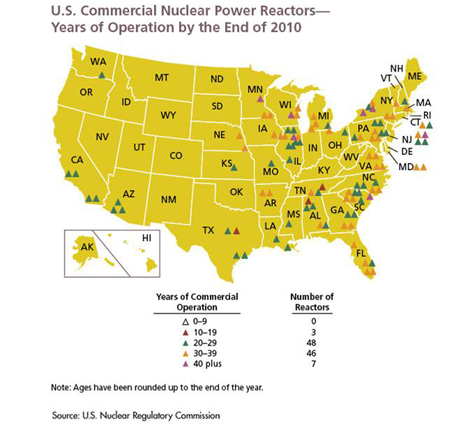Sixty hurricane Katrinas or 112 Sandys is the cost
EDF, the French company
that wants to build a new nuke at Calvert Cliffs in Maryland,
avoided revealing through
 “fabricated” reports that “very seriously underestimated the costs of” a potential serious nuclear accident in France.
The real cost would range from 0.76 trillion to 5.8 trillion euros ($1 trillion to $7.62 trillion dollars).
For comparison,
the Gross Domestic Product (GDP) of France is about 2.11 trillion euros,
according to the World Bank.
So a Chernobyl- or Fukushima-style accident in France
would cost ⅓ to 2¾ times French GDP.
No country can afford that.
“fabricated” reports that “very seriously underestimated the costs of” a potential serious nuclear accident in France.
The real cost would range from 0.76 trillion to 5.8 trillion euros ($1 trillion to $7.62 trillion dollars).
For comparison,
the Gross Domestic Product (GDP) of France is about 2.11 trillion euros,
according to the World Bank.
So a Chernobyl- or Fukushima-style accident in France
would cost ⅓ to 2¾ times French GDP.
No country can afford that.
Not even the U.S., whose GDP is $14.99 trillion or $11.41 euros, so such an accident, esp. if it happened in the densely populated eastern U.S., as for example in Maryland, could cost half the GDP of the United States. That’s way beyond the $68 billion cost of Hurricane Sandy or $125 billion for Hurricane Katrina. One nuclear accident could cost more than twice the $4 to $6 trillion for the Iraq and Afghanistan wars combined.
Wolf Richter wrote for Business Insider 14 March 2013, French Nuclear Disaster Scenario Was So Bad The Government Kept It Secret,
“There was no political smoothening, no pressure,” claimed IRSN [Institute for Radiological Protection and Nuclear Safety] (Director General Jacques Repussard, but he admitted, “it’s difficult to publish these kinds of numbers.” He said the original report with a price tag of €5.8 trillion was designed to counter the reports that EDF had fabricated, which “very seriously underestimated the costs of the incidents.”
Quatre-vingt-dix millions de personnes touchéesLa facture de 5.800 milliards illustre les conséquences colossales d’un accident très improbable mais pas impossible. “Il y a un coût social astronomique dû au grand nombre de victimes”, explique le rapport. Dans ce cas extrême, 5 millions de personnes doivent être évacuées sur une zone de 87.000 km², équivalant à la superficie des régions Aquitaine et Midi-Pyrénées réunies. L’évacuation, le relogement, la décontamination des sols mais aussi le traitement des déchets coûteraient 475 milliards d’euros.
Le plus lourd tribut découle de l’impact économique sur la zone contaminée au césium 137, où habitent 90 millions de personnes. Une région de 850.000 km², qui correspond à la superficie de la France et de l’Allemagne. L’indemnisation des agriculteurs, des salariés, des entreprises, mais aussi les coûts environnementaux et les dépenses de santé explosent à 4.400 milliards d’euros. Son auteur nuance : “C’est un coût social, mais les victimes ne seront pas nécessairement indemnisées.”
A “not atypical” accident at Dampierre near Orleans on the Loire River (the 5.8 trillion euro case) could contaminate soil with cesium-137 in an area the size of France and Germany combined, on top of evacuating 5 million people and affecting 90 million people. The evacuation zone alone would be the size of the French regions Aquitaine and Mid-Pyrenees combined. Evacuation, housing, and decontamination of soil and waste could cost 475 billion euros. The author of the report noted:
“It is a social cost, but the victims will not necessarily be compensated.”
Check your insurance. It probably doesn’t cover nuclear accidents.
This is all according to the story that broke this news, leJDD (the Sunday Journal), 10 March 2013, Le scénario noir du nucléaire.
Oh, the contamination zone from Dampierre would probably include London and Munich, not to mention Paris. A contamination zone from Calvert Cliffs in Maryland would include what? DC, Richmond, New York City, and all of New Jersey and Connecticut? Where’s the similar scenario?
What if it was recently caught-fire Cattenom in northeast France instead of Dampierre? The contamination zone would have a good chance of reaching Berlin. What about Copenhagen, Stockholm, and Oslo? Where’s the scenario for Cattenom?
And why would we want EDF building nukes in the U.S.? Until 2 August 2103, you can comment directly on the NRC hearing on foreign ownership.
 And where’s the similar scenario for
Plant Vogtle or Plant Hatch?
Why do we want Southern Company building more reactors near us?
They’re only doing it because
we’re paying for it and they’re not.
You can
file a complaint
with the Georgia Public Service Commssion about Georgia Power’s involvement in that.
You could mention
“Docket # 36498: Georgia Power Company 2013 IRP Filing”
and ask for distributed rooftop solar power and offshore wind instead.
And where’s the similar scenario for
Plant Vogtle or Plant Hatch?
Why do we want Southern Company building more reactors near us?
They’re only doing it because
we’re paying for it and they’re not.
You can
file a complaint
with the Georgia Public Service Commssion about Georgia Power’s involvement in that.
You could mention
“Docket # 36498: Georgia Power Company 2013 IRP Filing”
and ask for distributed rooftop solar power and offshore wind instead.
-jsq
Short Link: